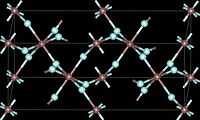Chromium trifluoride
 | |
 | |
| Names | |
|---|---|
| IUPAC name
Chromium(III) fluoride | |
| Identifiers | |
| 7788-97-8 16671-27-5 (trihydrate) 123333-98-2 (tetrahydrate) | |
| ChemSpider | 8329529 |
| |
| Jmol-3D images | Image Image |
| PubChem | 10154021 |
| RTECS number | GB6125000 |
| |
| Properties | |
| CrF3 | |
| Molar mass | 108.9913 g/mol (anhydrous) 163.037 g/mol (trihydrate) 181.05 g/mol (tetrahydrate) |
| Appearance | green crystalline solid |
| Density | 3.8 g/cm3 (anhydrous) 2.2 g/cm3 (trihydrate) |
| Melting point | 1,100 °C (2,010 °F; 1,370 K) (sublimes) |
| negligible (anhydrous) sparingly soluble (trihydrate) | |
| Solubility | insoluble and alcohols soluble in HF, HCl |
| Structure | |
| Crystal structure | Rhombohedral, hR24 |
| Space group | R-3c, No. 167 |
| Except where noted otherwise, data is given for materials in their standard state (at 25 °C (77 °F), 100 kPa) | |
| | |
| Infobox references | |
Chromium(III) fluoride is the name for the inorganic compounds with the chemical formula CrF3 as well as several related hydrates. The compound CrF3 is a green crystalline solid that is insoluble in common solvents, but the coloured hydrates [Cr(H2O)6]F3 and [Cr(H2O)6]F3•3H2O are soluble in water. The trihydrate is green, and the hexahydrate is violet. The anhydrous form sublimes at 1100–1200 °C. Like almost all compounds of chromium(III), these compounds feature octahedral Cr centres. In the anhydrous form, the six coordination sites are occupied by fluoride ligands that bridge to adjacent Cr centres. In the hydrates, some or all of the fluoride ligands are replaced by water.[1]
Production
Chromium(III) fluoride is produced from the reaction of chromium(III) oxide and hydrofluoric acid:[2]
- Cr2O3 + 6 HF + 9 H2O → 2 [Cr(H2O)6]F3
The anhydrous form is produced from hydrogen fluoride and chromic chloride:[3]
- CrCl3 + 3 HF → CrF3 + 3 HCl
Uses
Chromium(III) fluoride is not heavily used, but finds some applications as a mordant in textiles and as a corrosion inhibitor.
References
- ↑ F.H. Herbstein, M. Kapon and G.M. Reisner, "Crystal structures of chromium(III) fluoride trihydrate. Structural chemistry of hydrated transition metal fluorides. Thermal decomposition of chromium(III) fluoride nonhydrate" Zeitschrift für Kristallographie 1985, volume 171, pp. 209
- ↑ Gerd Anger, Jost Halstenberg, Klaus Hochgeschwender, Christoph Scherhag, Ulrich Korallus, Herbert Knopf, Peter Schmidt, Manfred Ohlinger, "Chromium Compounds" in Ullmann's Encyclopedia of Industrial Chemistry, Wiley-VCH, Weinheim, 2005.doi:10.1002/14356007.a07_067
- ↑ Greenwood, N. N.; & Earnshaw, A. (1997). Chemistry of the Elements (2nd Edn.), Oxford:Butterworth-Heinemann. ISBN 0-7506-3365-4.
| ||||||||||||||||||||||||||||||||||